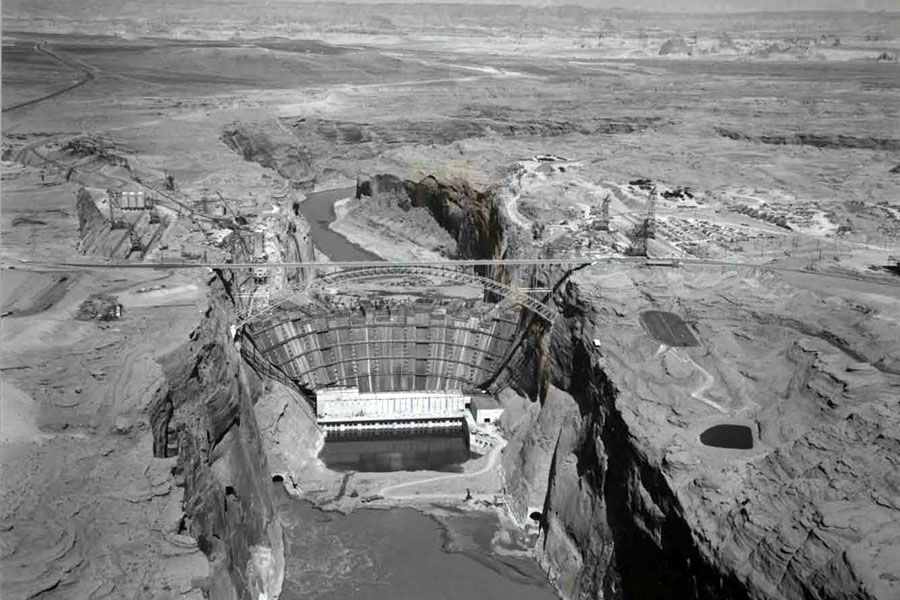
Imagine a massive federal proposal to transform large parts of the United States. The plan would alter (some say destroy) wilderness areas, but its backers argue that the economic benefits would outweigh the environmental impacts. The stakes are high: Supporters say their states can’t grow or even survive without it, while opponents want to preserve nature—or at least get their share of natural resources.
This happened 65 years ago, when Congress debated a plan to build dozens of dams along the Colorado River. I examined hundreds of news articles, editorials, and columns about the proposal. They appeared from 1954 through 1956 in the New York Times, Los Angeles Times, Denver Post, Rocky Mountain News, Salt Lake Tribune, and Deseret News. The Colorado and Utah papers promoted the dams, while New York and California papers opposed them.
The newspapers had complex motivations. I found that the California, Colorado, and Utah newspapers of the 1950s reflected frontier values of the 1800s. They portrayed the West as a barren place without enough water to support their populations—especially fast-growing Los Angeles. Because water was scarce, they fought over it, but for somewhat different reasons. The Colorado and Utah papers argued that the dams would enable their states to prosper economically and prevent California from taking “their” water. The Los Angeles Times wanted water for growth, too, but it also highlighted the natural beauty of the dam sites. The New York Times went a step further, emphasizing the importance of conservation. Thus, the coastal papers engaged in “proto-environmental” journalism that anticipated major issues of today, such as climate change, wildfires, and drought.
This article could be incorporated into journalism, media history, and environmental studies courses.
Framing
My article did not apply framing theory to the historical coverage I examined, but students could examine current coverage of Colorado River issues with this in mind.
Activity/questions:
- Read the “Persistent, Harsh Frontier” and “Boosterism, Budgets, and Bananas” sections of the article. What did pro-dam accounts give salience to? How did they describe the concerns of people in Colorado and Utah? How did the Denver and Salt Lake City newspapers portray the economic potential of the dams?
- Read the “Contributions to Environmental Journalism” section of the article. What issues did the New York Times and Los Angeles Times highlight? What concerns did they express? How did they portray potential recreational or conservation benefits?
- The Colorado River debates of the 1950s are echoed today. For example, a historic “megadrought” has drastically reduced water flows, forcing some states to cut how much they take from the river. Two recent articles can be used to explore contemporary framing. Read Christopher Flavelle’s New York Times article and note the overall focus, beginning in the first five paragraphs. What values are most evident in this article? What are the controversies? Next, read Elena Shao’s New York Times article, noting the graphical depiction and focus of her story. What do you see in her coverage? What are the stakes as she presents them? These are climate-beat reporters for the New York Times; how does their coverage compare with recent stories by the Associated Press?
Readings:
- The Associated Press, Colorado River topic page, https://apnews.com/hub/colorado-river
- Christopher Flavelle, “A Breakthrough Deal to Keep the Colorado River From Going Dry, for Now,” New York Times, May 22, 2023, https://www.nytimes.com/2023/05/22/climate/colorado-river-deal.html
- Elena Shao, “The Colorado River Is Shrinking. See What’s Using All the Water,” New York Times, May 22, 2023, https://www.nytimes.com/interactive/2023/05/22/climate/colorado-river-water.html
Journalism Standards and Practices
Debates about journalistic objectivity go far back. My article about Colorado River dam coverage is, in part, a story about advocacy versus reporting. The Colorado and Utah newspapers didn’t just take an editorial stance in favor of the dam project; they actively sought to influence the outcome. The papers worked in close partnership with the Aqualantes (a pro-dam organization) by printing membership coupons alongside news stories and encouraging readers to donate money and join. Most notably, one Utah paper lent a reporter to a group that traveled to Washington to lobby for the dams.
In this context, students could examine objectivity by considering “both-sidesism” versus informed judgment. Both-sidesism is a fairly recent term describing news coverage that gives equal time to opposing sides of issues in order to appear impartial. The problem is that reporting on some issues, like climate change or vaccines, cannot be simplistically balanced because, for example, there is overwhelming scientific consensus on climate change.
The idea of objectivity as informed judgment is more nuanced. Author Declan Fahy argues that environmental journalists have long understood the limitations of rote objectivity, and they have developed “trained judgment,” which lets them use their expertise to contextualize and explain scientific processes, debates, and areas of agreement.
Activity/questions:
- Read the “Journalists as Participants: The Aqualantes Campaign” section of the article. Can you find recent examples of journalists taking part in stories they’re covering?
- Read John B. Oakes’s 1955 New York Times article, which impartially explains the contrasting opinions about the Colorado River dam project. Then, consider the Los Angeles Times’s Martin Litton, who said his own articles “were very, very one-sided: that is, they told the right side” because “I just wanted the so-called ‘development’ to stop.” By laying out both sides of the dam controversy, did Oakes’s story lapse into both-sidesism? What value did his impartial story bring to readers? Can you tell that Oakes believed passionately in conserving the rivers in their natural state? What are the strengths and weaknesses of Litton’s advocacy approach?
- Read Fahy’s article and consider his observations about journalists using expert judgment to decide how to report claims. Then, read the Pew Research Center study showing that three-fourths of Americans think journalists should always strive to give all sides equal coverage. What are the strengths and weaknesses of these approaches?
Readings:
- Declan Fahy, “Objectivity as Trained Judgment: How Environmental Reporters Pioneered Journalism for a ‘Post-truth’ Era,” Environmental Communication 12, no. 7 (2018): 855-61, https://doi.org/10.1080/17524032.2018.1495093
- Naomi Forman-Katz and Mark Jurkowitz, “U.S. Journalists Differ from the Public in Their Views of ‘Bothsidesism’ in Journalism,” Pew Research Center, July 13, 2022, https://www.pewresearch.org/short-reads/2022/07/13/u-s-journalists-differ-from-the-public-in-their-views-of-bothsidesism-in-journalism/
- Oral history interview with Martin Litton, Northern Arizona University Cline Library, October 10, 1992, http://archive.library.nau.edu/digital/collection/cpa/id/63428/rec/7
- John B. Oakes, “Partisan Feelings Running High on the Colorado River Project,” New York Times, June 14, 1955, 22 (available via ProQuest).
New Western History
Three decades ago, a group of historians offered a counter-narrative to traditional U.S. frontier history by rebutting notions of White settlement as progress. Instead, Patricia Nelson Limerick argued, the pioneers represented conquest and exploitation. Donald Worster added to this academic movement by showing that settlers saw the arid West as a potential garden, a place to “make the desert bloom.” Part of the motivation for my article was curiosity about the usefulness of New Western History in interpreting journalism history, and it can be applied to coverage of economic and environmental issues today.
Activity/questions:
- The Associated Press has extensively covered contemporary Colorado River issues. Many current problems are related to the 1950s project examined in my article. Read two or three AP stories and see if you can find sources mentioning what Limerick described as conquest or exploitation. How does the AP’s coverage reflect Worster’s portrayal of a naturally arid West?
- Read Dave Marston’s column for Writers on the Range. How does his historical context clarify today’s issues of flooding, drought, and climate change?
Readings:
- The Associated Press, Colorado River topic page, https://apnews.com/hub/colorado-river
- Patricia Nelson Limerick, “What on Earth Is the New Western History?” Montana: The Magazine of Western History 40 no. 3 (1990): 61-64 (available via JSTOR).
• Dave Marston, “Atmospheric Rivers Endanger the West,” Writers on the Range, January 23, 2023, https://writersontherange.org/atmospheric-rivers-endanger-the-west/
Photo: Glen Canyon Dam under construction, circa 1960-63. Source: U.S. Bureau of Reclamation, https://www.usbr.gov/uc/rm/crsp/gc/ (“History” tab)
About the author: Glen Feighery (University of Utah) is the author of “Wear the Blue Star: Frontier Values vs. Environmentalism in News Coverage of Colorado River Dams, 1954-1956,” in the Spring 2023 issue of Journalism History.

